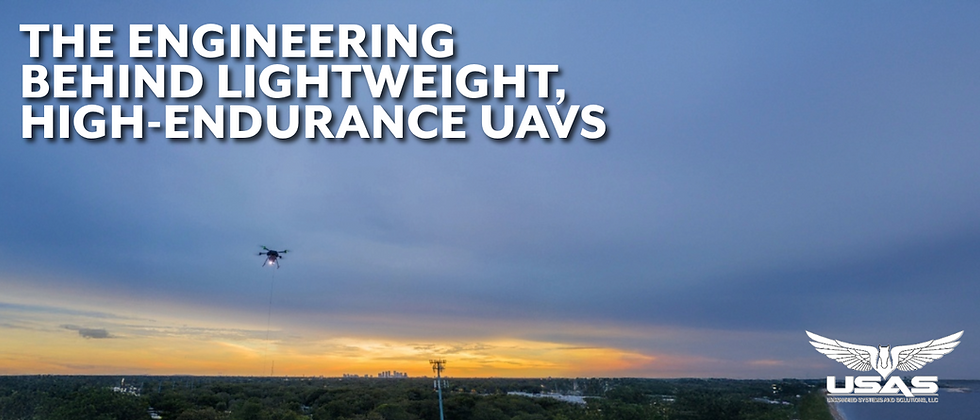The Engineering Behind Lightweight, High-Endurance UAVs
- USaS Staff
- May 12
- 2 min read
Unlocking Performance in Tethered Drone Systems

In the evolving landscape of defense, public safety, and industrial monitoring, the demand for persistent aerial surveillance and communication is higher than ever. Unmanned Aerial Vehicles (UAVs), particularly tethered drones, are at the forefront of this transformation. But what allows these systems to stay aloft for hours—or even days—without failure? The answer lies in the meticulous engineering behind lightweight, high-endurance UAVs.
The Challenge: Endurance vs. Payload
Traditionally, the trade-off in UAV design has been simple: longer flight times often mean reduced payload capacity, while heavier equipment limits airborne endurance. Engineers have had to find creative ways to break that compromise—especially in tethered drone systems, where performance and reliability are non-negotiable.
Tethered drones, unlike their free-flying counterparts, are physically connected to a power and data source on the ground via a specialized tether. This eliminates battery constraints and allows for continuous operation, but also imposes strict requirements on the drone’s weight, power consumption, and structural design.
Lightweight Materials and Structural Optimization
To support long-duration missions, engineers rely on advanced composite materials—carbon fiber, aramid reinforcements, and high-strength thermoplastics—to keep tethered UAVs ultralight without compromising durability. Every gram matters. Components are often topology-optimized using AI-assisted CAD tools, ensuring that structures can withstand high wind loads while maintaining minimum weight.
Beyond materials, aerodynamic efficiency plays a critical role. Blended wing designs, streamlined bodies, and optimized propeller geometries help reduce drag and power consumption, enabling higher endurance with a smaller propulsion system.
The Power of the Tether
The tethered drone’s greatest asset is its tether. Engineered to carry both power and high-bandwidth data, modern tethers use lightweight, reinforced cables with integrated fiber optics and copper wiring. Thermal regulation, electromagnetic shielding, and tensile strength are all critical considerations in tether design.
Unlike wireless drones, tethered drone systems can transmit uncompressed, real-time video and telemetry with virtually zero latency. This makes them invaluable for operations that require secure and constant situational awareness—like border monitoring, crowd surveillance, or battlefield communications.
Flight Control and Thermal Management
Prolonged operation introduces heat buildup in onboard electronics. To address this, UAVs in tethered drone systems incorporate passive and active thermal management, from heatsinks and ventilated enclosures to temperature-regulated flight controllers.
Precision autopilot software also plays a key role. Flight stability must be maintained even as the tether moves in wind, changes tension or adds mechanical noise. Advanced onboard IMUs, GPS failover systems, and AI-powered stabilization algorithms allow for centimeter-level hover accuracy even in unpredictable environments.
Modular Payloads and Swappable Platforms
Modern tethered drones aren’t one-size-fits-all. Modular designs allow operators to rapidly swap payloads—thermal cameras, LiDAR, ISR sensors, or mesh radio relays—based on mission demands. This modularity also contributes to endurance, as lighter payloads can reduce energy consumption, further extending mission runtime.
Many platforms are designed to be reconfigured for man-portable, vehicle-mounted, or fixed-site deployments—offering flexibility without adding unnecessary weight.
Conclusion: Engineering for Mission Success
The engineering behind lightweight, high-endurance UAVs is a multidisciplinary effort—blending aerodynamics, materials science, power electronics, and embedded systems. In tethered drone systems, every detail is fine-tuned to support continuous, reliable performance in demanding conditions.
As new materials, AI-driven controls, and power delivery methods continue to evolve, tethered drones will only become more capable—serving as persistent eyes in the sky for missions that cannot afford a moment offline.




Kommentare